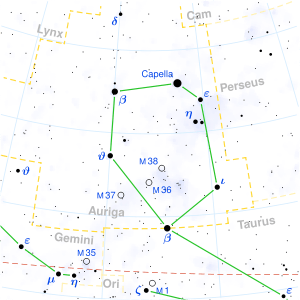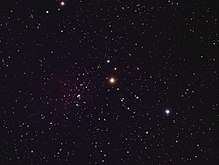Phi Aurigae
Phi Aurigae, Latinized from φ Aurigae, is a giant star in the northern constellation of Auriga. It is faintly visible to the naked eye with an apparent visual magnitude of 5.089.[2] It lies 10′ from another faint naked-eye star HD 35520, between the three open clusters M36 and M38, and NGC 1893.
 | |
| Observation data Epoch J2000 Equinox J2000 | |
|---|---|
| Constellation | Auriga |
| Right ascension | 05h 27m 38.88417s[1] |
| Declination | +34° 28′ 33.1639″[1] |
| Apparent magnitude (V) | 5.089[2] |
| Characteristics | |
| Spectral type | K3 IIIp[3] |
| U−B color index | +1.649[2] |
| B−V color index | +1.411[2] |
| R−I color index | 0.47 |
| Astrometry | |
| Radial velocity (Rv) | +30.78[4] km/s |
| Proper motion (μ) | RA: –1.324[1] mas/yr Dec.: –38.746[1] mas/yr |
| Parallax (π) | 6.7629 ± 0.1659[1] mas |
| Distance | 480 ± 10 ly (148 ± 4 pc) |
| Absolute magnitude (MV) | −0.62[5] |
| Details | |
| Radius | 32[6] R☉ |
| Luminosity | 242 - 247[6] L☉ |
| Surface gravity (log g) | 1.75[3] cgs |
| Temperature | 3,986[6] K |
| Metallicity [Fe/H] | –0.03[3] dex |
| Rotational velocity (v sin i) | 1.6[7] km/s |
| Other designations | |
| Database references | |
| SIMBAD | data |

φ Aurigae in optical light
The distance to this star, as determined from parallax measurements, is approximately 480 light-years (150 parsecs) with a 10 light-year margin of error.[9] This is an evolved giant star with a stellar classification of K3 IIIp[3] and an estimated radius equal to 16 times the radius of the Sun. The outer envelope has an effective temperature of 4,367 K,[3] giving it the cool orange-hued glow of a K-type star.
References
- Brown, A. G. A.; et al. (Gaia collaboration) (August 2018). "Gaia Data Release 2: Summary of the contents and survey properties". Astronomy & Astrophysics. 616. A1. arXiv:1804.09365. Bibcode:2018A&A...616A...1G. doi:10.1051/0004-6361/201833051. Gaia DR2 record for this source at VizieR.
- Jennens, P. A.; Helfer, H. L. (September 1975), "A new photometric metal abundance and luminosity calibration for field G and K giants.", Monthly Notices of the Royal Astronomical Society, 172: 667–679, Bibcode:1975MNRAS.172..667J, doi:10.1093/mnras/172.3.667.
- Cenarro, A. J.; et al. (January 2007), "Medium-resolution Isaac Newton Telescope library of empirical spectra - II. The stellar atmospheric parameters", Monthly Notices of the Royal Astronomical Society, 374 (2): 664–690, arXiv:astro-ph/0611618, Bibcode:2007MNRAS.374..664C, doi:10.1111/j.1365-2966.2006.11196.x.
- Famaey, B.; et al. (January 2005), "Local kinematics of K and M giants from CORAVEL/Hipparcos/Tycho-2 data. Revisiting the concept of superclusters", Astronomy and Astrophysics, 430 (1): 165–186, arXiv:astro-ph/0409579, Bibcode:2005A&A...430..165F, doi:10.1051/0004-6361:20041272.
- Anderson, E.; Francis, Ch. (2012), "XHIP: An extended hipparcos compilation", Astronomy Letters, 38 (5): 331, arXiv:1108.4971, Bibcode:2012AstL...38..331A, doi:10.1134/S1063773712050015.
- Messineo, M.; Brown, A. G. A. (2019). "A Catalog of Known Galactic K-M Stars of Class I Candidate Red Supergiants in Gaia DR2". The Astronomical Journal. 158: 20. arXiv:1905.03744. Bibcode:2019AJ....158...20M. doi:10.3847/1538-3881/ab1cbd.
- De Medeiros, J. R.; et al. (November 2000), "Rotation and lithium in single giant stars", Astronomy and Astrophysics, 363: 239–243, arXiv:astro-ph/0010273, Bibcode:2000A&A...363..239D.
- "* phi Aur". SIMBAD. Centre de données astronomiques de Strasbourg. Retrieved 2012-08-23.
- van Leeuwen, Floor (November 2007), "Validation of the new Hipparcos reduction", Astronomy and Astrophysics, 474 (2): 653–664, arXiv:0708.1752v1, Bibcode:2007A&A...474..653V, doi:10.1051/0004-6361:20078357. Note: see VizieR catalogue I/311.
External links
This article is issued from Wikipedia. The text is licensed under Creative Commons - Attribution - Sharealike. Additional terms may apply for the media files.